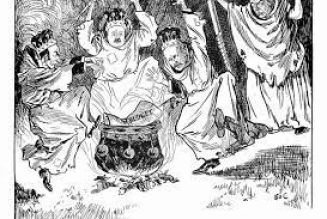Executed in the Salem Witches hysteria of 1692–93 by being pressed to death for not acknowledging the right of the court to try him on charges of witchcraft.
Giles Corey was a well-to-do man of Salem Town, in his 80s when the hysteria started.
He owned a farm of 100 acres and other properties as well.
Though hardworking, he was not entirely well regarded, having a reputation for being quarrelsome and “scandalous.” Long before the hysteria, Corey was regarded as the reason for just about anything that went bad in Salem Town.
In 1676, he was rumored to have beaten a farmhand who subsequently died.
Corey was arrested and charged with murder, but the jury found him not guilty, believing the man to have died of a non-related disease.
Corey paid a fine and was set free.
Two years later, Corey was in court again, this time in a lawsuit brought by a laborer over a wage dispute.
The court found against Corey.
He was married to Martha Corey, his third wife, who was condemned as a witch and hung on September 22, 1692.
When the hysteria began in early 1692, Corey believed in witches as the cause of the girls’ afflictions.
He differed with Martha, who was skeptical.
Corey did not distinguish himself as the hysteria spread and Martha became one of the victims.
In fact, he even spoke against her and was willing to testify against her in her trial.
Then he defended her innocence, denying things he’d said, thus making himself out to be a liar— one of the gravest of sins in Puritan eyes.
The tables turned on him when the afflicted girls cried out against him, calling him a wizard and saying they had seen his specter about town.
Corey may have seen the handwriting on the wall, for he made out a will bequeathing his properties and possessions to two of his sons-inlaw.
He then refused to answer his indictment.
Under the laws of New England, a person who refused to answer an indictment could not be tried.
If Corey could not be tried and found guilty, then his properties could not be seized by the state.
However, the law allowed such a person to be tortured until they either answered or died.
The torture method chosen for Corey was pressing.
Corey was excommunicated on September 14, 1692.
He was taken out into a field and staked to the ground.
A wooden plank was placed over his body and then heavy stones were laid on top of the plank.
The weight was increased until Corey literally was pressed to death.
For two days he lay in agony, until at last he expired.
The weight pushed his tongue out of his mouth.
Sheriff Richard Corwin took his cane and pushed the tongue back in.
According to lore, Corey was asked repeatedly to answer the indictment, but replied only “More weight!”
His ghost is said to haunt the area where he died.
Corey’s excommunication was reversed on March 2, 1712.








